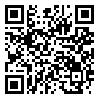Volume 17, Issue 1 (2020)
ioh 2020, 17(1): 1164-1173 |
Back to browse issues page
Download citation:
BibTeX | RIS | EndNote | Medlars | ProCite | Reference Manager | RefWorks
Send citation to:



BibTeX | RIS | EndNote | Medlars | ProCite | Reference Manager | RefWorks
Send citation to:
Yarahmadi R, Ghasemkhani M, Mortezapour Sofiani A, Sepidarkish M, Taheri F. Study of Comprehension of the Signs Passengers at Subway Stations in Tehran(case study). ioh 2020; 17 (1) :1164-1173
URL: http://ioh.iums.ac.ir/article-1-1838-en.html
URL: http://ioh.iums.ac.ir/article-1-1838-en.html
Rasoul Yarahmadi 

 , Mahdi Ghasemkhani *
, Mahdi Ghasemkhani * 

 , Alireza Mortezapour Sofiani
, Alireza Mortezapour Sofiani 

 , Mahdi Sepidarkish
, Mahdi Sepidarkish 

 , Fereshteh Taheri
, Fereshteh Taheri 




 , Mahdi Ghasemkhani *
, Mahdi Ghasemkhani * 

 , Alireza Mortezapour Sofiani
, Alireza Mortezapour Sofiani 

 , Mahdi Sepidarkish
, Mahdi Sepidarkish 

 , Fereshteh Taheri
, Fereshteh Taheri 


Occupational Health and Research Center, School of Health, Department of Occupational Public Health ,Iran University of Medical Sciences, Tehran, Iran . , qasemkj@tums.ac.ir
Abstract: (2503 Views)
Background and aims:Safety signs are an important tool as converting information for recognizing the event, type, severity, and control of actual hazards in the environment. The main importance of displaying safety signs is to prevent injury and aware people of the potential hazards in particular situations in different environments. The aim of this study was conducted to determine the level of perception of Tehran city train passengers about the existing safety and warning signs and to provide an appropriate solution to improve the perception level at the metro stations.
Methods: Because the lack of access to the standard questionnaire in the present research, a researcher-created questionnaire was used based on design and manufacturing criteria, test and installation methods accordance to ISO 9186 and ISO 3864 international standards. For this purpose, by forming an expert panel, the research questions were identified and evaluated in relation to the topic, the degree of clarity, and the ease of comprehension. Stratified random sampling was conducted against 390 persons. And the Chi-square tests for datum analysis were performed using SPSS software.
Results: According to the results, the highest perceived symbols belong to smoking symbol with 98 percent and 97 percent perceive the symbol prohibited entry of domestic animals. Symbol “no entry” with 5 percent of Understanding with the lowest level was understandable. The analytical results of this study can be a direct impact on understanding due to education level (Pvalue <0.001) and negative impact on the understanding of symbols mentioned age and income (Pvalue <0.003).
Conclusion: Considering the increasing development of metro lines and the results of the different understanding of each symbol in order to remove or eliminate the hazards, further studies are a necessity. The use of training for ergonomic redesign symbols is undeniable, and decision makers need to devote appropriate resources to teaching symptoms. The visual components of the environment affect the clarity and readability of the symptoms. The shape and size of a sign and board, as well as the size of the letters and position, are effective in understanding. Therefore, in addition to designing based on the psychological and physiological principles, other important factors such as continuous adjustment of symbols distance and height are necessary. When designing text for signs and signs, the space of letters, the space between the lines, the position of symbols and decorative patterns, the margins and the use of upper or lower case letters (in Latin) are important.
Methods: Because the lack of access to the standard questionnaire in the present research, a researcher-created questionnaire was used based on design and manufacturing criteria, test and installation methods accordance to ISO 9186 and ISO 3864 international standards. For this purpose, by forming an expert panel, the research questions were identified and evaluated in relation to the topic, the degree of clarity, and the ease of comprehension. Stratified random sampling was conducted against 390 persons. And the Chi-square tests for datum analysis were performed using SPSS software.
Results: According to the results, the highest perceived symbols belong to smoking symbol with 98 percent and 97 percent perceive the symbol prohibited entry of domestic animals. Symbol “no entry” with 5 percent of Understanding with the lowest level was understandable. The analytical results of this study can be a direct impact on understanding due to education level (Pvalue <0.001) and negative impact on the understanding of symbols mentioned age and income (Pvalue <0.003).
Conclusion: Considering the increasing development of metro lines and the results of the different understanding of each symbol in order to remove or eliminate the hazards, further studies are a necessity. The use of training for ergonomic redesign symbols is undeniable, and decision makers need to devote appropriate resources to teaching symptoms. The visual components of the environment affect the clarity and readability of the symptoms. The shape and size of a sign and board, as well as the size of the letters and position, are effective in understanding. Therefore, in addition to designing based on the psychological and physiological principles, other important factors such as continuous adjustment of symbols distance and height are necessary. When designing text for signs and signs, the space of letters, the space between the lines, the position of symbols and decorative patterns, the margins and the use of upper or lower case letters (in Latin) are important.
Type of Study: Research |
Subject:
Safety
Received: 2019/06/27 | Accepted: 2021/02/3 | Published: 2020/05/30
Received: 2019/06/27 | Accepted: 2021/02/3 | Published: 2020/05/30
Send email to the article author
| Rights and permissions | |
 |
This work is licensed under a Creative Commons Attribution-NonCommercial 4.0 International License. |



